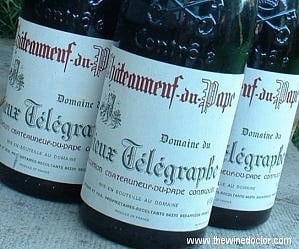Vieux Télégraphe Châteauneuf du Pape 1988
Châteauneuf du Pape is the original French appellation; the regulations that were instituted following the campaigning of Baron Le Roy, a retired World War I fighter pilot and proprietor of Château Fortia, formed the basis of the Appellation d’Origine Contrôlée system, which now stipulates how and where wine is produced in all France. Perhaps this little piece of history explains, in a small way, why Châteauneuf du Pape is so well known today, although I suspect the easy way in which the name rolls off the tongue is a much more significant factor, as well as the inherent quality of the wines, of course.
In recent years the popularity of these wines has also been boosted by the critic Robert Parker. The effect has been tangible; Châteauneuf du Pape seems more popular than ever. New oak is important for those seeking pointy awards, a super-cuvée helps; extraction, bâtonnage, toasted oak and more. Châteauneuf du Pape on steroids is the result. I was conversing (electronically) with Bernard Tranchecostes, winemaker at Domaine des Sénéchaux, quite recently, and this was one of the topics discussed. Tranchecostes, like me, also seemed to feel that the single cuvée is the right path to be treading (this is the case at Sénéchaux – more details on my chat with Tranchecostes and Thierry Caymaris, winemaker at Château du Trignon in Gigondas, here). There are a few others with the same philosophy that spring immediately to mind, including the Avril family at Clos des Papes, and the Bruniers at Vieux Télégraphe. At both estates quality is assured by weeding out the lesser vats, to be sold off or to be bottled as a second wine, both practices which seem inherently admirable to me. In neither case do they cream off the best wines for the sake of a few lines in a wine newsletter, no matter how well circulated and influential.

This week’s wine is testament to what the Brunier family achieve at Vieux Télégraphe with this philosophy. This wine, the 1988 Châteauneuf du Pape from Vieux Télégraphe, comes from a time when control of the estate was in the process of transfer, being handed down from Henri Brunier to his two sons, Daniel and Frederic. I pulled this bottle from the cellar this weekend, and decanted it just an hour or so before drinking; it just got better and better as the evening wore on, so decanting slightly earlier might have been advantageous. It had a beautifully mature hue when poured, almost brick red at the rim, deeper and more freshly coloured at the core. But it is the nose that really alerts to the quality; a little dumb at first, but before long revealing notes of roasted meats and white pepper, along with a savage, animalistic, somewhat earthy and feral character. Soft, warm and cushioning on entry, remaining very plump and matronly through the midpalate, revealing just a little of the structure that lies beneath, which shows more on the finish. This is no shrinking violet; it may be ageing with finesse, but there is still a fabulous lick of tannin beneath as well. And there is fruit on the midpalate. It is very fine now, but the signs suggest this will continue along this plateau of drinkability for some time. Nice length, too! Just lovely. 18/20 (14/8/06)
Find Vieux Télégraphe Châteauneuf du Pape 1988 on Wine Searcher: ![]()
